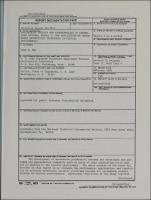Please use this identifier to cite or link to this item:
https://hdl.handle.net/11681/13087Full metadata record
| DC Field | Value | Language |
|---|---|---|
| dc.contributor.author | May, John R. (John Robert), 1934- | - |
| dc.date.accessioned | 2016-07-18T15:00:30Z | - |
| dc.date.available | 2016-07-18T15:00:30Z | - |
| dc.date.issued | 1982-02 | - |
| dc.identifier.uri | http://hdl.handle.net/11681/13087 | - |
| dc.description | Technical Report | - |
| dc.description | Abstract: The development of waterborne geophysical systems and techniques has provided the geotechnical community with an array of data acquisition tools that can be applied to the fluvial environment. The major purpose of the study described in this report is to evaluate the performance, application, and capability of selected waterborne acoustic profiling systems for streambank erosion studies in fluvial environments. Additional objectives of the study reported herein were to present types of available survey systems and related support equipment and to describe techniques for using the systems and equipment. The principal types of acoustic survey systems discussed in this report are: (a) continuous seismic reflection profiling (CSRP) systems, (b) sidescanning sonar systems, and (c) bathymetric profiling systems. Basic system components, i.e., sound sources, graphic recorders, hydrophones, transceivers, etc. are identified . The operational principles and characteristics of system components are discussed. System limitations and environmental constraints, i.e., frequency, resolution, water depths, weather, bottom and subbottom composition, porosity and density of sediments, etc., are described. Support equipment requirements for conducting waterborne geophysical surveys, i.e., survey boats, positioning equipment, bathymetric profiling systems, and sampling equipment, are also included. Personnel requirements , selection of survey systems, collection and use of background and historical information, and suggested operation and towing techniques for waterborne geophysical systems are additional topics discussed in the report. Several study areas were selected for the employment and evaluation of waterborne geophysical systems. The study areas were located on the White River, Lower and Middle Mississippi River, Missouri River, and the Ohio River. The physiographic, geologic, and hydrologic characteristics of the study areas and associated survey sites were integrated with the results of the surveys. The data collected at the survey sites included that from CSRP, side-scanning sonar, and bathymetric systems and are presented herein. The application of CSRP and side-scanning sonar systems in the survey sites revealed that the state of the art of these systems is sufficiently developed for application to streambank erosion studies, as well as other engineering, geologic, hydrologic, and hydraulic investigations in the fluvial environment. The CSRP technique provides a capability for the detection and identification of stratigraphic and structural geology, and to a lesser extent, lithologic features on and below the channel bottom. CSRP systems were determined to be particularly useful for locating bedrock below the channel bottom. Overall channel bottom characteristics can be determined by side-scanning sonar. The side-scanning sonar system detects natural features, i.e., sand waves, rock outcrops, scour holes, and subaqueous bank failures. Man-made features such as sunken boats and barges, pipelines, revetments, and miscellaneous debris are also detectable by side-scannning sonar systems. CSRP and side-scanning sonar systems can be most successfully applied for periodic routine or special purpose monitoring. The bottom and subbottom data acquired for each period, or survey, can be compared and changes or trends in channel conditions can be identified. Acoustic profiling surveys can be particularly significant where streambank erosion, subaqueous bank failures, or other adverse fluvial conditions are persistently active or have been intermittently active historically. | - |
| dc.publisher | Geotechnical Laboratory (U.S.) | - |
| dc.publisher | Engineer Research and Development Center (U.S.) | - |
| dc.relation | http://acwc.sdp.sirsi.net/client/en_US/search/asset/1015380 | - |
| dc.relation.ispartofseries | Technical report (U.S. Army Engineer Waterways Experiment Station) ; GL-79-7 rept. 3. | - |
| dc.rights | Approved for public release; distribution is unlimited. | - |
| dc.source | This Digital Resource was created from scans of the Print Resource | - |
| dc.subject | White River | - |
| dc.subject | Mississippi River | - |
| dc.subject | Missouri River | - |
| dc.subject | Ohio River | - |
| dc.subject | Engineering geology | - |
| dc.subject | Geology | - |
| dc.subject | Geomorphology | - |
| dc.subject | Rivers | - |
| dc.subject | Streams | - |
| dc.subject | Erosion | - |
| dc.subject | Bank erosion | - |
| dc.subject | Geophysical instruments | - |
| dc.subject | Equipment | - |
| dc.title | Engineering geology and geomorphology of streambank erosion. Report 3, The application of waterborne geophysical techniques in fluvial environments | - |
| dc.type | Report | en_US |
| Appears in Collections: | Technical Report | |
Files in This Item:
| File | Description | Size | Format | |
|---|---|---|---|---|
| TR-GL-79-7-V3.pdf | 26.72 MB | Adobe PDF |  View/Open |